Processing of Secondary Raw Materials from Ferrochrome Production via Agglomeration and Study of Their Mechanical Properties
Abstract
1. Introduction
2. Materials and Methods
- M 400 cement.
- Bentonite clay powder.
- Polyacrylamide binder (PAA).
- Polymer binder based on epoxy resins (PB).
- Binder based on modified lignosulfonate (LM).
2.1. Method of Briquetting on a Laboratory Press
2.2. Vibrobriquetting Technique
2.3. Extrusion Technique
2.4. Pelletizing Method on a Disk Granulator
2.5. Methods for Determining Strength Characteristics
- I—strength index, %
- M+5—mass of the fraction greater than 5 mm
- Mtotal—initial mass.
3. Test Results
4. Results and Discussion
5. Conclusions
- -
- Agglomeration of WSRMs mixed with rich dusts using the vibro-pressing method, regardless of the amount of binder used, does not make it possible to obtain briquettes with the required strength characteristics for further metallurgical processing;
- -
- The use of extrusion and granulation methods makes it possible to obtain agglomerated products in the form of briquettes and pellets, whose strength indicators fully meet the requirements for agglomerated materials used in ferrochrome production;
- -
- The use of polymer (PB) and organic (LM) binders, which possess burnout properties at high temperatures, does not dilute the chromium-containing raw materials, allowing for the production of agglomerated material with a chromium oxide (Cr2O3) content of no less than 35%. The light hydrocarbon fractions of the organic and polymer binders combust at temperatures of 500–650 °C, while the remaining carbon framework contributes to the formation of a porous structure in the material and provides a reducing potential during metallurgical smelting.
- -
- These methods enable efficient processing of fine-grained wastes of varying particle sizes and moisture content, including WSRM, without requiring complete pre-drying;
- -
- Agglomeration is carried out at low temperatures, which significantly reduces energy consumption during the preparation of secondary raw materials compared to the firing of pellets and sinters;
- -
- The absence of high-temperature processing minimizes the formation of toxic gases and reduces atmospheric emissions;
- -
- The resulting braxes and pellets exhibit high mechanical strength, are resistant to transport, and do not disintegrate when fed into the furnace melting zone.
Author Contributions
Funding
Data Availability Statement
Conflicts of Interest
References
- Oterdoom, H.; Reuter, M.; Zietsman, J. DC Ferrochrome Smelting: The Arcing Zone and Its Influence on Energy Transport and Exergy Dissipation. Metall. Mater. Trans. B 2025, 56, 890–912. [Google Scholar] [CrossRef]
- Yessenzhulov, A.; Abdulabekov, E. The New and Reconstructed Facilities at the Enterprise TNK Kazchrome JSC. In Proceedings of the Best Available Technologies for Steel and Ferroalloys Production, Moscow, Russia, 14 October 2020. [Google Scholar]
- Shabanov, E.Z.; Saulebek, Z.K.; Akhmetov, A.S.; Mukhtarkhanova, G.K. Smelting of High-Carbon Ferrochromium from Pre-Reduced Chromite Raw Materials. CIS Iron Steel Rev. 2024, 27, 15–19. [Google Scholar] [CrossRef]
- Kapan, S.; Çamdali, Ü.; Celik, N. Determination of the Mass Balance of High-Carbon Ferrochrome in a Submerged Arc Furnace. High Temp. Mater. Processes 2024, 28, 1–8. [Google Scholar] [CrossRef]
- Raj, H.; Paswan, D.N.; Jha, S.K. Optimization of Process Parameter for Smelting and Reduction of Ferrochrome. Int. J. Eng. Res. Technol. 2016, 5, 509–513. [Google Scholar]
- Jundibayev, M.K.; Myrzagaliev, A.A. Review of methods for agglomeration of chromium-containing dust and gas-cleaning sludge in ferrochrome smelting. Bull. Aktobe Reg. Univ. K. Zhubanov 2025, 1, 235–241. [Google Scholar]
- Zhuchkov, V.I.; Zayakin, O.V.; Sychev, A.V. Slags and Dusts of Ferroalloy Production. Russ. Metall. Metally 2020, 2020, 662–666. [Google Scholar] [CrossRef]
- Ajay, C.; Durga, R. Sustainable Use of Ferrochrome Slag and Quarry Dust Composites as Cement-Bound Layers of Flexible Pavement. Glob. NEST J. 2024, 26, 1–9. [Google Scholar] [CrossRef]
- Zapate, V.; Patil, V.A.; Takkalaki, S.R.; Sawant, R.S. Effect of Ferrochrome Slag as Partial Replacement of Coarse Aggregate on Strength and Durability of Concrete. Int. Eng. J. Res. Dev. 2023, 8, 7. [Google Scholar]
- Al-Jabri, K.S. Research on the Use of Ferro-Chrome Slag in Civil Engineering Applications. MATEC Web Conf. 2018, 149, 01017. [Google Scholar] [CrossRef]
- Jena, S.; Panigrahi, R. Evaluation of Durability and Microstructural Properties of Geopolymer Concrete with Ferrochrome Slag as Coarse Aggregate. Iran J. Sci. Technol. Trans. Civ. Eng. 2021, 46, 1201–1210. [Google Scholar] [CrossRef]
- Kozhamuratov, R.U.; Safarov, R.Z.; Shomanova, Z.K.; Nosenko, Y.G. Recycling of Ferroalloy Production Waste. In Proceedings of the International Scientific Conference “Global Science and Innovations 2017”, Bursa, Turkey, 4 December 2017; pp. 207–213. [Google Scholar]
- Zhuchkov, V.I.; Zayakin, O.V.; Sychev, A.V. The Study of the Characteristics and Possibilities of Using Slags and Dusts from Ferrochrome Production. In Proceedings of the Infacon XVI: International Ferro-Alloys Congress, Trondheim, Norway, 27–29 September 2021. [Google Scholar] [CrossRef]
- Zhuchkov, V.I.; Leontyev, L.I.; Zayakin, O.V. Promising Measures to Reduce the Harmful Effects of Man-made Waste from Ferroalloy Production. KnE Mater. Sci. 2019, 5, 263–270. [Google Scholar] [CrossRef]
- Myrzagaliev, A.A.; Almagambetov, M.S.; Alimbaev, S.A.; Ulmaganbetov, N.A. The Use of Poor Chromium-Containing Braces for Smelting High-Carbon Ferrochrome. Bull. Sci. 2020, 1, 342–349. [Google Scholar]
- Zhunusov, A.K.; Tolymbekova, L.B.; Bykov, P.O.; Zayakin, O.V. Melting Ferrochrome Using Chrome-Ore Briquettes. Metallurgist 2023, 67, 606–613. [Google Scholar] [CrossRef]
- Omarova, A.E.; Isagulova, D.A.; Kvon, S.S.; Kovaleva, T.V. The Choice of Binder for the Production of Briquettes from Highly Dispersed Dust of Ferroalloy Production. Proc. Univ. 2023, 3, 79–83. [Google Scholar] [CrossRef]
- Pavlov, A.V.; Alimbaev, S.A.; Murzagaliev, A.A.; Khalitov, T.V. The Use of Poor Chromium-Containing Cans for Smelting High-Carbon Ferrochrome. In Proceedings of the International Scientific Conference “Physico-Chemical Foundations of Metallurgical Processes Named After Academician A.M. Samarin”, Vyksa, Russia, 10–14 October 2019; pp. 66–67. [Google Scholar]
- Kascheev, I.D.; Zhuchkov, V.I.; Zayakin, O.V. Forming and Utilizing Ferrochromium Production Waste. Mater. Sci. Forum 2020, 989, 492–497. [Google Scholar] [CrossRef]
- Salkynbaev, B.Z.; Musabekov, Z.B.; Dosekenov, M.S.; Almukhamedova, A.K. Processing of Aspiration Dust from High-Carbon Ferrochrome Crushing. Bull. Aktobe Reg. Univ. Named K. Zhubanov 2021, 3, 79–83. [Google Scholar]
- Makhambetov, Y.; Akhmetov, A.; Gabdullin, S.; Shabanov, Y.; Toleukadyr, R.; Saulebek, Z.; Myrzagaliyev, A. Study of Ferrochrome Smelting Technology Using Briquettes with Various Carbonaceous Reducers. Acta Metall. Slovaca 2024, 30, 113–119. [Google Scholar] [CrossRef]
- Sokic, M.; Markovic, D.; Korac, M. Agglomeration of Ferroalloy Wastes for Recycling in Metallurgical Processes. Metalurgija 2019, 58, 81–84. [Google Scholar]
- Sariyev, O.; Abdirashit, A.; Almagambetov, M.; Nurgali, N.; Kelamanov, B.; Yessengaliyev, D.; Mukhambetkaliyev, A. Assessment of Physicochemical Properties of Dust from Crushing High-Carbon Ferrochrome: Methods for Agglomeration. Materials 2025, 18, 903. [Google Scholar] [CrossRef] [PubMed]
- Sariyev, O.; Almagambetov, M.; Nurgali, N.; Abikenova, G.; Kelamanov, B.; Yessengaliyev, D.; Abdirashit, A. Development of a Briquetting Method for Dust from High-Carbon Ferrochrome Crushing Using Vibropressing on an Industrial Scale and Its Subsequent Remelting. Materials 2025, 18, 2608. [Google Scholar] [CrossRef]
- Mikic, T.; Sokic, M.; Dimitrijevic, M. Recycling and Briquetting of Sludge from Wet Gas Cleaning of Ferroalloy Production. Metall. Mater. Eng. 2022, 28, 313–324. [Google Scholar]
- Shomanova, Z.; Safarov, R.; Tashmukhambetova, Z.; Sassykova, L.; Nosenko, Y.; Mukanova, R. Complex Research of Ferroalloys Production Wastes by Physical and Chemical Methods. J. Chem. Technol. Metall. 2021, 56, 629–636. [Google Scholar]
- Dorofeev, G.A.; Barsukova, E.Y. On the Choice of a Rational Method for Agglomeration of Fine Materials of Technogenic and Natural Origin. Bull. Sci. Tech. Econ. Inf. Ferrous Metall. 2015, 12, 73–80. [Google Scholar]
- Das, R.; Mondal, M.K.; Pramanik, S. Effect of Extrusion on the Physical and Mechanical Properties of Briquette Made with Blast Furnace Flue Dust and Iron Ore Fines. J. Inst. Eng. India Ser. D 2022, 103, 473–478. [Google Scholar] [CrossRef]
- Bizhanov, A.M.; Malysheva, T. Metallurgical Properties of Blast Furnace Extruded Briquettes (BREX) Based on Hematite Concentrate. Mater. Sci. Forum 2020, 989, 492–497. [Google Scholar] [CrossRef]
- Kurunov, I.; Bizhanov, A. Stiff Extrusion Briquetting in Metallurgy; Topics in Mining, Metallurgy and Materials Engineering; Springer International Publishing: Cham, Switzerland, 2018; Volume 1, p. 169. [Google Scholar] [CrossRef]
- GOST 24765-81; Iron Ore Materials. Method for Determination of Cold Crushing Strength. Committee for Standards of the Council of Ministers of the USSR: Moscow, Russia, 1981.
- GOST 25471-82; Iron Ore Raw Materials. Method for Determination of Drop Strength. Committee for Standards of the Council of Ministers of the USSR: Moscow, Russia, 1982.
- GOST 15137-77; Iron Ore Raw Materials. Method for Determination of Strength under Impact and Abrasion. Committee for Standards of the Council of Ministers of the USSR: Moscow, Russia, 1978.


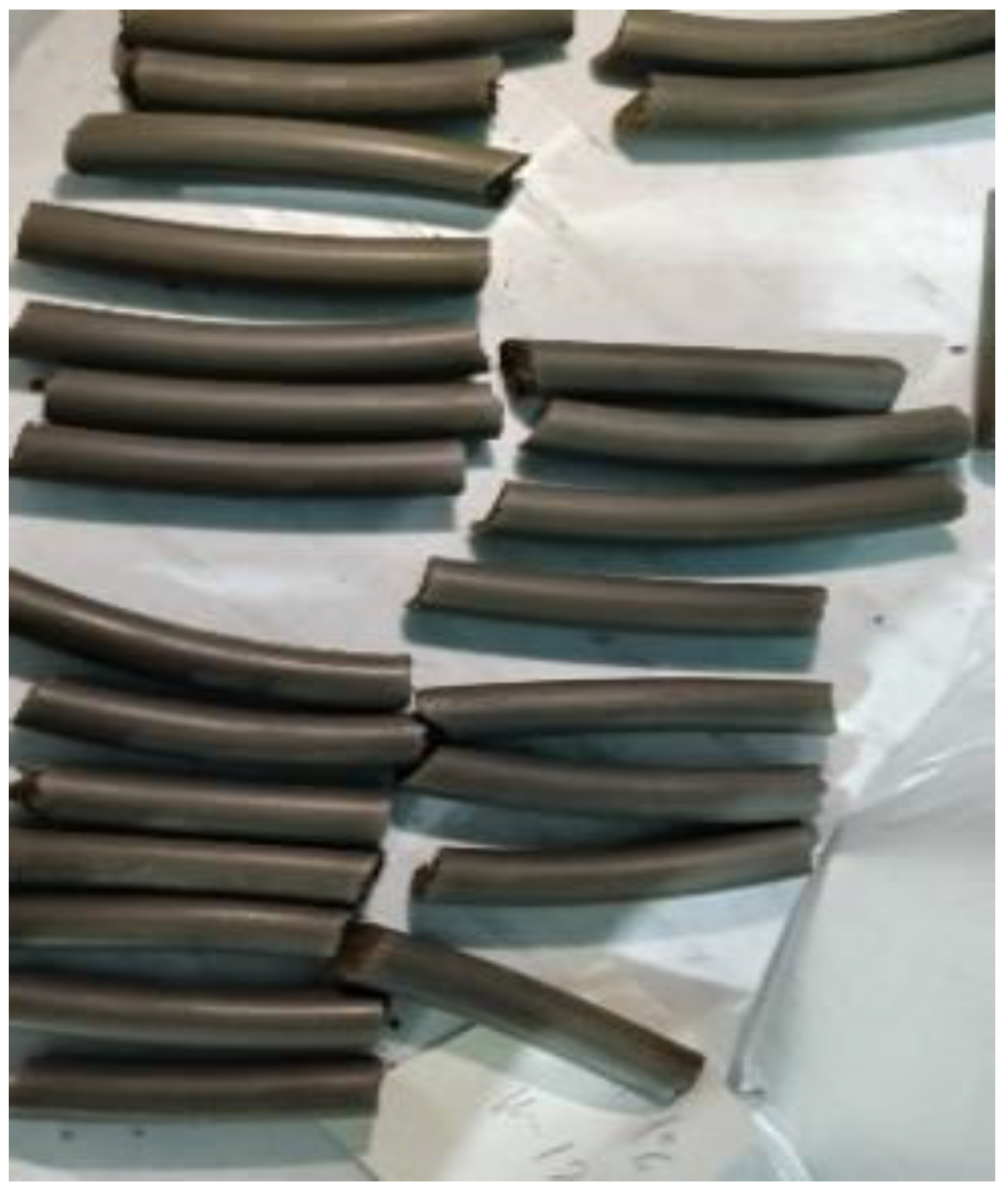
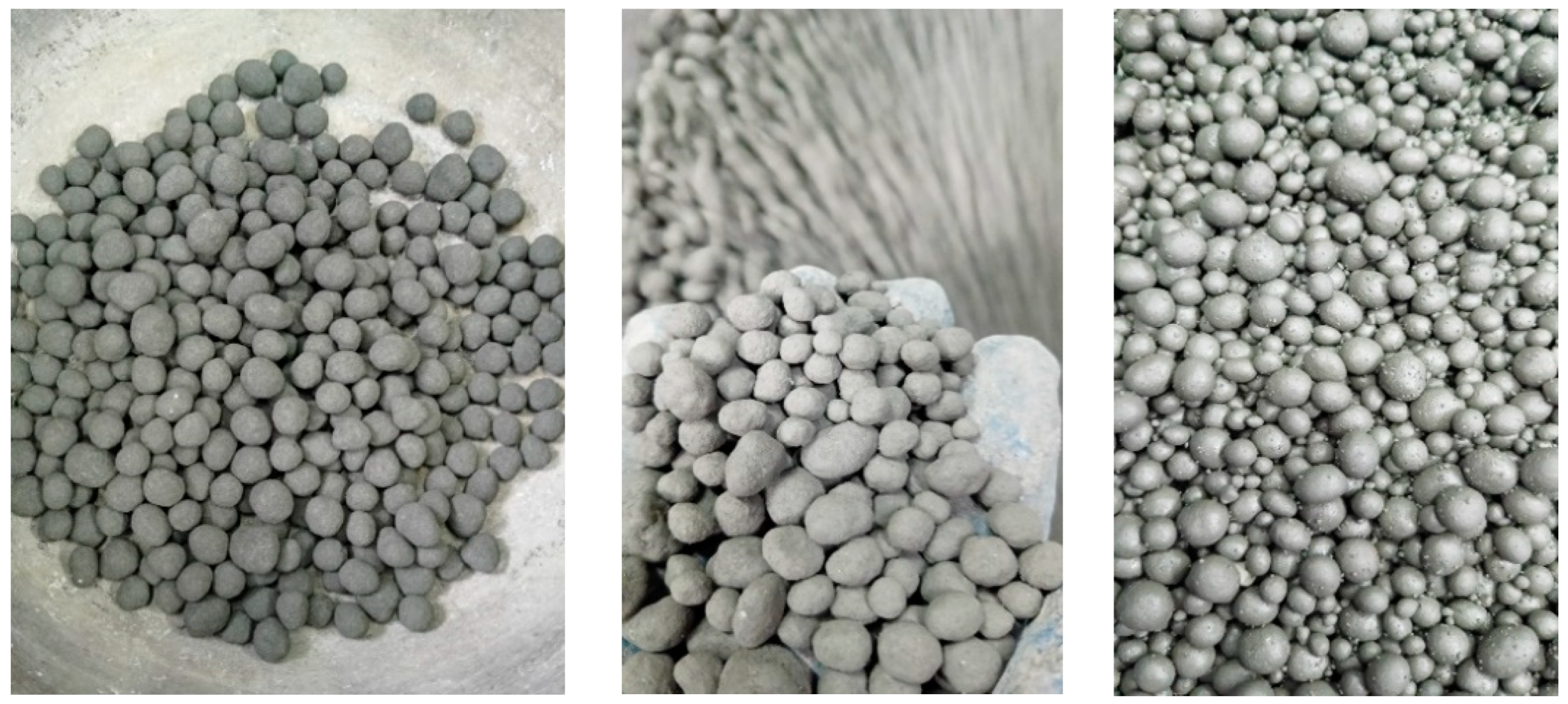



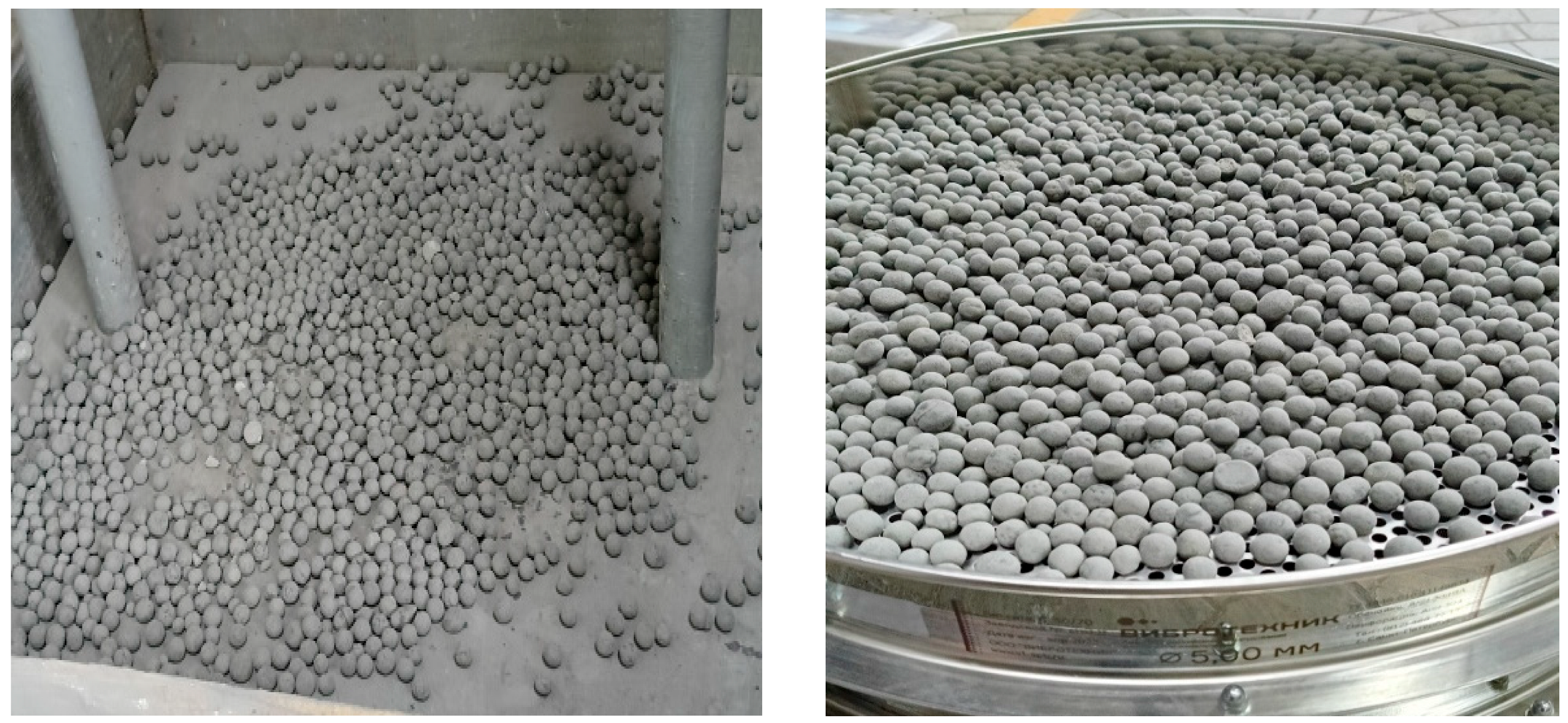
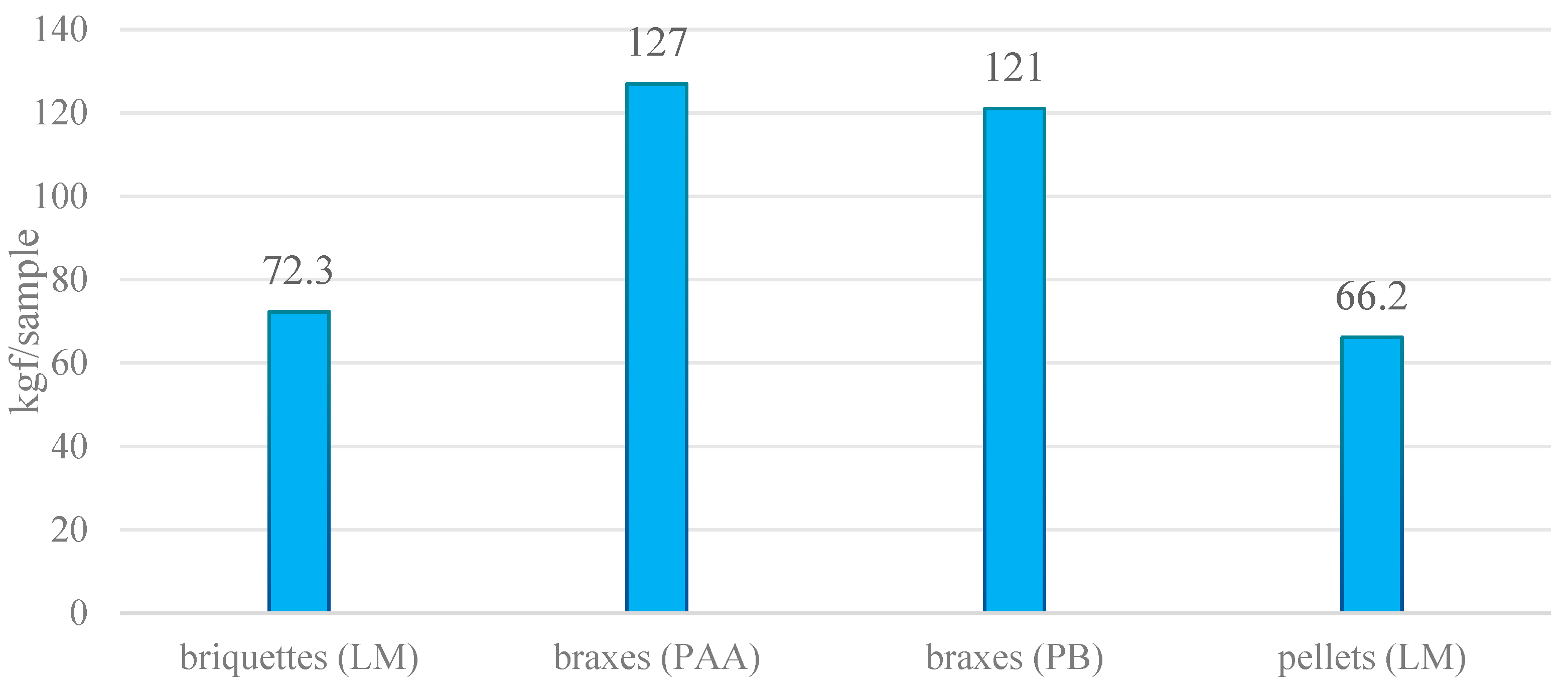
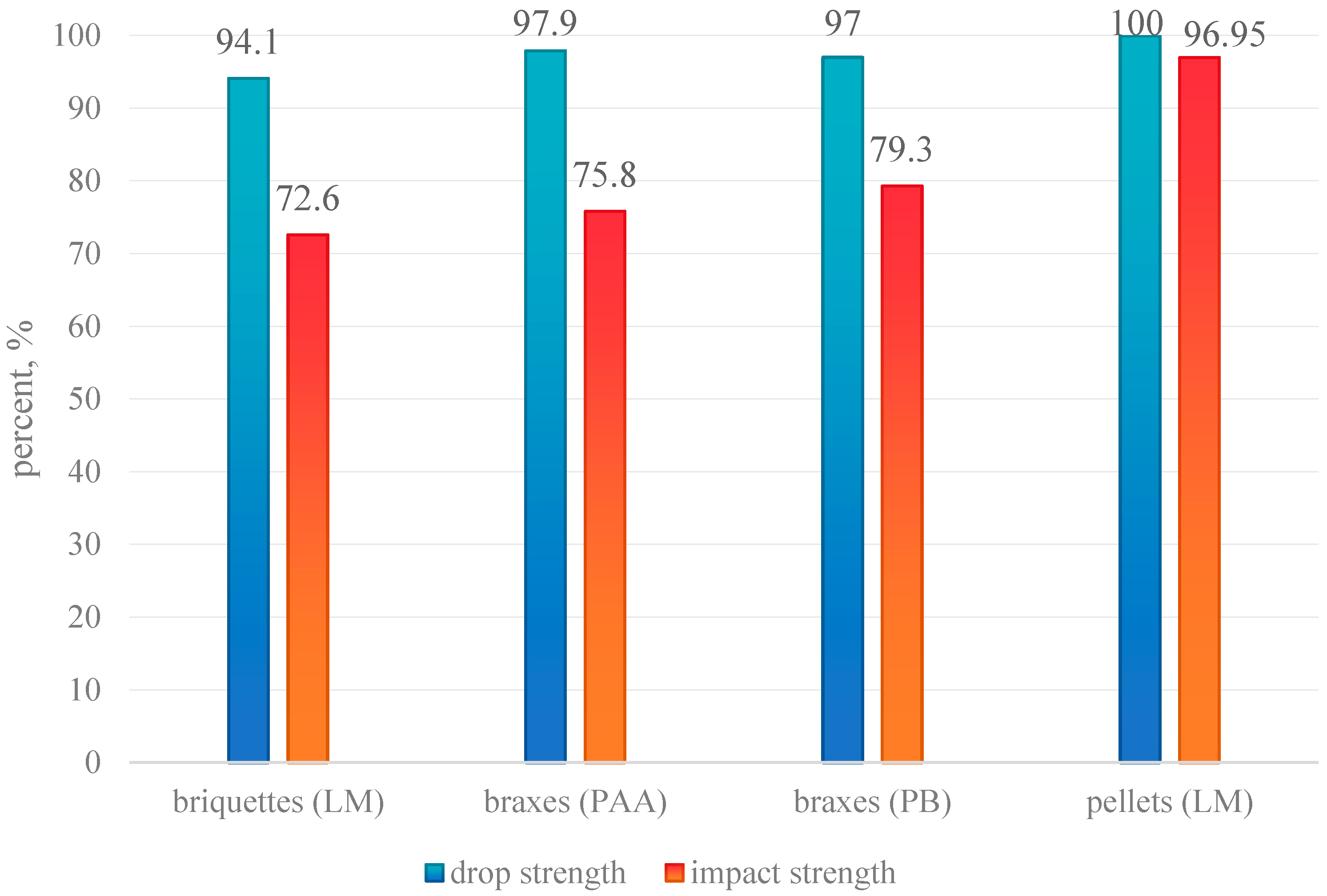
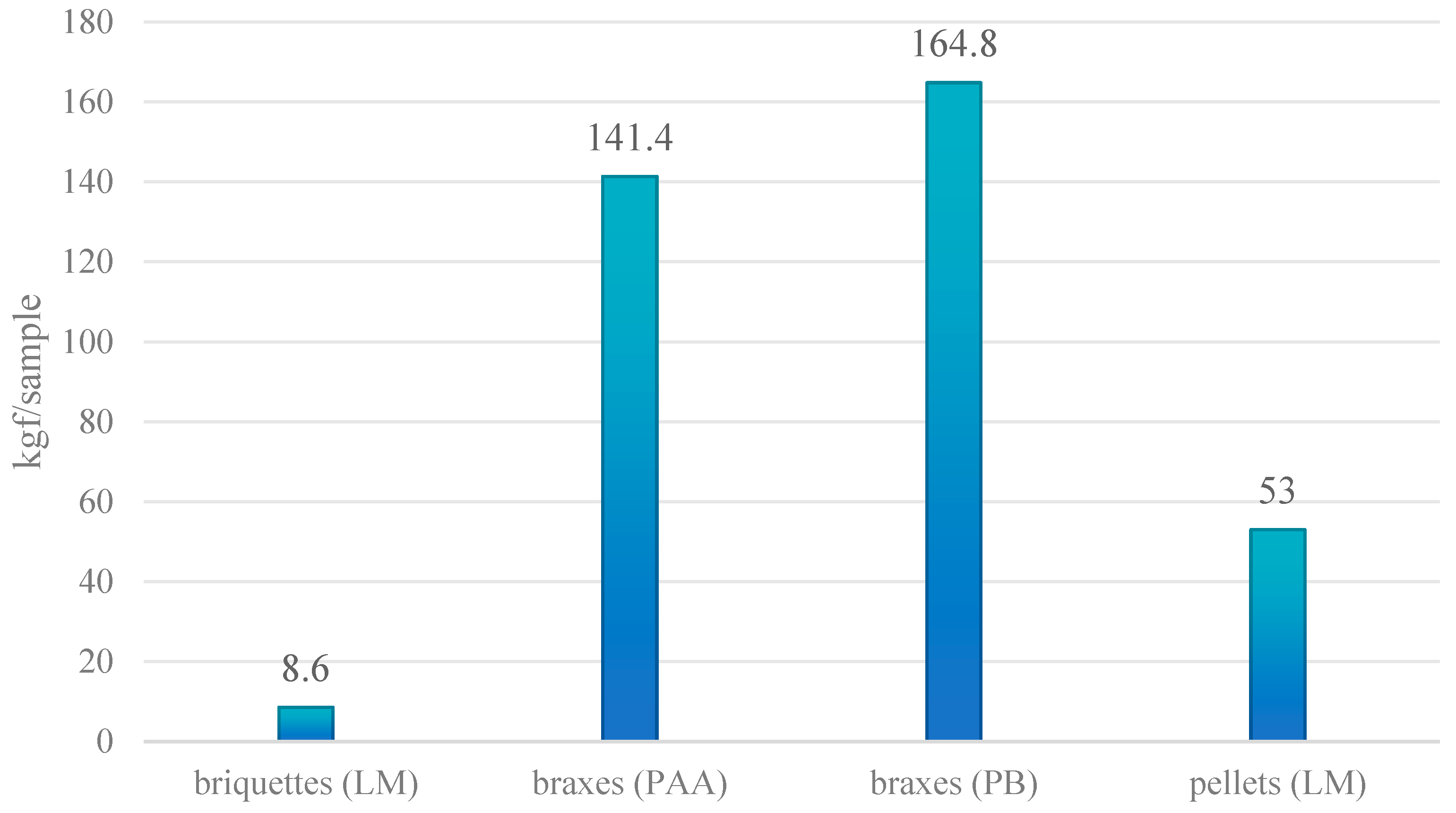
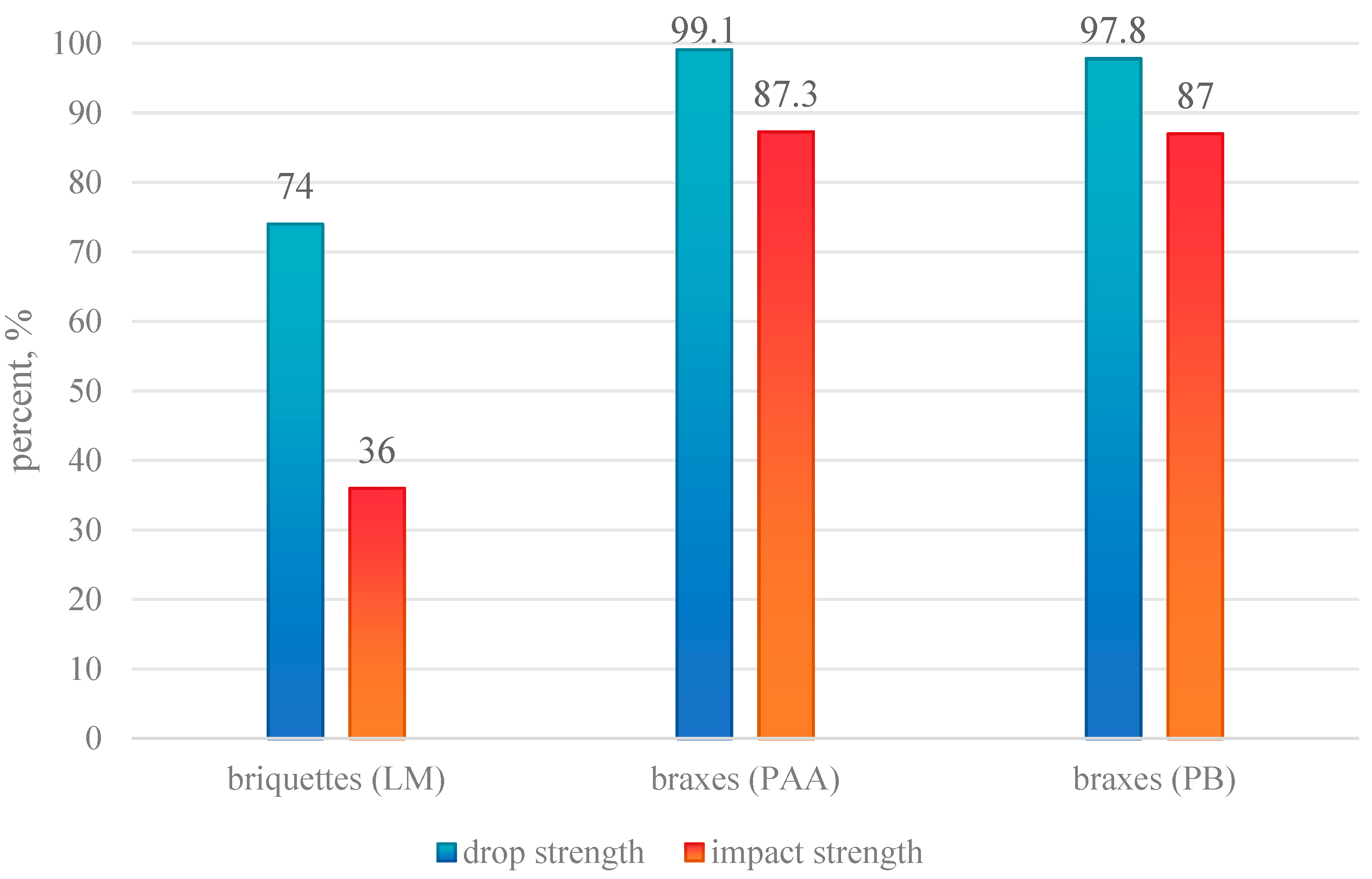
| Material | Content, % | ||||||||
|---|---|---|---|---|---|---|---|---|---|
| Cr2O3 | SiO2 | CaO | MgO | Al2O3 | FeO | C | S | P | |
| WSRM | 25.6 | 19.3 | 0.9 | 35.6 | 4.9 | 8.7 | 4.4 | 0.49 | 0.01 |
| Dust No.1 | 41.3 | 11.5 | 1.1 | 19.8 | 7.3 | 13.4 | 5.2 | 0.16 | 0.01 |
| Dust No.2 | 45.2 | 11.3 | 0.5 | 20.4 | 7.2 | 12.1 | 1.4 | 0.04 | 0.01 |
| № | Binder Type | Binder Consumption, % | Moisture *, % | Splitting Strength, kgf/Briquette | ||
|---|---|---|---|---|---|---|
| 1 Day | 3 Days | 120 °C 3 h | ||||
| 1 | Cement | 4 | 10 | 33.0 | 25.0 | 39.6 |
| 2 | Cement | 5 | 10 | 31.0 | 34.0 | 37.0 |
| 3 | PAA | 1 | 10 | 45.6 | 95.3 | 100.0 |
| 4 | PAA | 2 | 10 | 48.3 | 212.0 | 191.0 |
| 5 | PAA/cement | 1/4 ** | 10 | 46.6 | 121.3 | 89.0 |
| 6 | PB | 1 | 10 | 21.0 | 33.0 | 28.3 |
| 7 | PB | 2 | 10 | 24.0 | 80.0 | 57.6 |
| 8 | PB/Cement | 1/4 ** | 10 | 23.6 | 42.0 | 28.6 |
| Binder Type | Binder Consumption, % | Moisture, % | Type of Test | Drying Method | |
|---|---|---|---|---|---|
| 3 Days | 120 °C 5 h | ||||
| LM | 4 | 8 | splitting strength, kg/briquette | 8.6 | 72.3 |
| impact resistance, % (+5 mm) | 36.0 | 72.6 | |||
| abrasion resistance, % (−0.5 mm) | 39.0 | 11.3 | |||
| drop strength, % (+5 mm) | 74.0 | 94.1 | |||
| No. | Binder Type | Binder Consumption, % | Moisture, % | Splitting Strength, kgf/Brax | ||
|---|---|---|---|---|---|---|
| 1 Day | 3 Days | 120 °C 3 h | ||||
| 1 | Bentonite | 6 | 14 | 32.6 | 75.4 | 107.0 |
| 2 | 8 | 14 | 33.2 | 71.0 | 122.2 | |
| 3 | PAA | 1 | 12 | 45.8 | 141.4 | 127.0 |
| 4 | PAA/Bentonite | 1/3 * | 13 | 64.0 | 178.4 | 96.2 |
| 5 | PB | 1 | 12 | 31.4 | 164.8 | 121.0 |
| 6 | 2 | 12 | 43.4 | 205.4 | 107.4 | |
| 7 | PB/Bentonite | 1/3 * | 13 | 59.4 | 179.4 | 59.0 |
| 8 | LM | 3 | 10 | 0 | 55.2 | 148.2 |
| Binder Type | Binder Consumption, % | Moisture, % | Type of Test | Drying Method | |
|---|---|---|---|---|---|
| 3 Days | 120 °C 5 h | ||||
| PAA | 1 | 12 | splitting strength, kgf/brax | 141.4 | 127.0 |
| impact resistance, % (+5 mm) | 87.3 | 75.8 | |||
| abrasion resistance, % (−0.5 mm) | 9.4 | 18.0 | |||
| drop strength., % (+5 mm) | 99.1 | 97.9 | |||
| PB | 1 | 12 | splitting strength, kgf/brax | 164.8 | 121.0 |
| impact resistance, % (+5 mm) | 87.0 | 79.3 | |||
| abrasion resistance, % (−0.5 mm) | 10.1 | 17.8 | |||
| drop strength., % (+5 mm) | 97.8 | 97.0 | |||
| No. | Binder Type | Binder Consumption, % | Moisture, % | Splitting Strength, kgf/Pellet | ||
|---|---|---|---|---|---|---|
| 1 Day | 3 Days | 120 °C 3 h | ||||
| 1 | Bentonite | 1 | 9.5 | 3.0 | 6.9 | 7.0 |
| 2 | Bentonite | 2 | 4.2 | 7.6 | 7.8 | |
| 3 | LM | 2 | 9.4 | 41.8 | 49.0 | |
| 4 | LM | 3 | 11.4 | 44.9 | 49.3 | |
| 5 | Bentonite/LM | 1/3 * | 9.2 | 9.4 | 9.8 | |
| 6 | PAA | 1 | 0 | 0 | 0 | |
| 7 | PAA | 2 | - | - | - | |
| 8 | PAA/Bentonite | 1/2 ** | 8.6 | 9.7 | 11.5 | |
| 9 | PB | 1 | 0 | 0 | 0 | |
| 10 | PB | 2 | 0 | 0 | 0 | |
| 11 | PB/Bentonite | 1/2 ** | 0 | 4.2 | 4.6 | |
| Binder Type | Binder Consumption, % | Moisture, % | Splitting Strength, kgf/Pellet | |||
|---|---|---|---|---|---|---|
| Raw | 1 Day | 3 Days | 120 °C 3 h | |||
| LM | 3 | 6 + 3 | 6.5 | 18.5 | 53.0 | 66.2 |
| Binder Type | Binder Consumption, % | Moisture, % | Splitting Strength of Pellets Dried at 120 °C, % | Drop Resistance of Pellets Dried at 120 °C, % | |
|---|---|---|---|---|---|
| Impact Strength, (+5 mm) | Abrasion Strength, (−0.5 mm) | +5 mm | |||
| LM | 3 | 6 + 3 | 96.9 | 1.9 | 100.0 |
Disclaimer/Publisher’s Note: The statements, opinions and data contained in all publications are solely those of the individual author(s) and contributor(s) and not of MDPI and/or the editor(s). MDPI and/or the editor(s) disclaim responsibility for any injury to people or property resulting from any ideas, methods, instructions or products referred to in the content. |
© 2025 by the authors. Licensee MDPI, Basel, Switzerland. This article is an open access article distributed under the terms and conditions of the Creative Commons Attribution (CC BY) license (https://creativecommons.org/licenses/by/4.0/).
Share and Cite
Zhumagaliyev, Y.; Shabanov, Y.; Almagambetov, M.; Jundibayev, M.; Ulmaganbetov, N.; Laikhan, S.; Jundibayeva, A.; Abilberikova, A.; Ubaidulayeva, N.; Adaibayeva, R. Processing of Secondary Raw Materials from Ferrochrome Production via Agglomeration and Study of Their Mechanical Properties. Metals 2025, 15, 878. https://doi.org/10.3390/met15080878
Zhumagaliyev Y, Shabanov Y, Almagambetov M, Jundibayev M, Ulmaganbetov N, Laikhan S, Jundibayeva A, Abilberikova A, Ubaidulayeva N, Adaibayeva R. Processing of Secondary Raw Materials from Ferrochrome Production via Agglomeration and Study of Their Mechanical Properties. Metals. 2025; 15(8):878. https://doi.org/10.3390/met15080878
Chicago/Turabian StyleZhumagaliyev, Yerlan, Yerbol Shabanov, Maral Almagambetov, Maulen Jundibayev, Nursultan Ulmaganbetov, Salamat Laikhan, Akgul Jundibayeva, Aigerim Abilberikova, Nurbala Ubaidulayeva, and Rysgul Adaibayeva. 2025. "Processing of Secondary Raw Materials from Ferrochrome Production via Agglomeration and Study of Their Mechanical Properties" Metals 15, no. 8: 878. https://doi.org/10.3390/met15080878
APA StyleZhumagaliyev, Y., Shabanov, Y., Almagambetov, M., Jundibayev, M., Ulmaganbetov, N., Laikhan, S., Jundibayeva, A., Abilberikova, A., Ubaidulayeva, N., & Adaibayeva, R. (2025). Processing of Secondary Raw Materials from Ferrochrome Production via Agglomeration and Study of Their Mechanical Properties. Metals, 15(8), 878. https://doi.org/10.3390/met15080878







